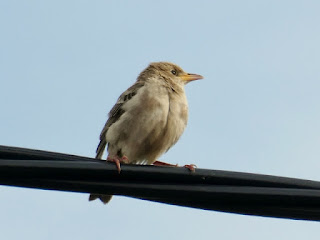October trundles on, not my favourite month of the year (the clocks go back, it gets darker for longer, the garden dies back, butterflies disappear, Halloween, Christmas on its way, cold, wet and windy, the central heating goes on, etc.). but at least it is nearly over. I'm feeling quite lethargic and listless and generally fed up but hopefully I'll shake off this fugue sometime soon.
A planned trip to the Avon Dam with Mavis was unfortunately cancelled but there have been very few Ring Ouzel sightings at this site so far this year along with reports of a poor Rowan berry crop and so it looks to be a Ring Ouzel-less year this year for me. However with a free day on Friday 22nd October David and I took a walk to the Avon Dam for a look around and while we had an enjoyable walk as always it was unfortunately Ring Ouzel-less as expected. In fact it was pretty birdless with just 3 Blackbirds, a Chaffinch, Woodpigeons, Carrion Crows, a Jay, a Kestrel, a Skylark and a few Great, Blue and Long-tailed Tits seen.
There were Rowan berries on the trees but maybe not so many as usual but in the past few days up to 14 Ring Ouzels have been seen at the Avon Dam so I guess we just got our timings wrong.
The weather is the usual October joy - cool, wet, windy, unsettled - and with few birds being reported I took a walk at Wembury on Wednesday 27th October on a blustery, cloudy morning. I wasnt expecting much but on arriving there were good numbers of Gannets swirling around offshore with quite a few close in around The Mewstone and so I set off along the muddy coast path towards The Point for a better look.
The Gannets were putting on quite a show, busily diving into the water and mostly adults but with juveniles and immatures amongst them. Also present were Kittiwakes including good numbers of juveniles with their smart black W upperwing markings being very noticeable along with the usual Herring, Black-headed and Great Black-backed Gulls.
Further offshore more Gannets and Kittiwakes were moving west but by around 12pm everything had moved through and the sky was empty save for a few Gulls. Right place, right time for a change.
Also seen along the walk were 3 Little Egret, 4 Curlew and 40 Oystercatcher roosting at The Point, 21 Mallard (13 male) around the Sewage Pipe, a Great Spotted Woodpecker at The Pines and 3 Buzzards overhead. A 1st winter Common Gull off the Main Beach and at least 3 Mediterranean Gulls amongst the feeding mellee added to the Gull species total for the day.
A planned Devonport Leat walk on Dartmoor on Thursday 28th October before a nights stay at The Two Bridges Hotel for our friend Julie's birthday was abandoned as the weather was so foul but the next morning the weather had improved and we managed a walk around Burrator Reservoir after our stay before heading home. Not much was seen in the way of birds but 5 Cormorant were drying their wings on the floating bridge while being watched by an adult Great Black-backed Gull and the resident White Goose was present at The Small Dam with a Canada Goose and Mallards.
I had Saturday 30th October to myself and was undecided as to where to go - Pendeen for a Brown Shrike, Slapton Ley for Snow Buntings or Berry Head for Pomarine Skuas and with gales and rain forecasted overnight on Friday 29th I chose Berry Head. However after an early start which saw me arriving at Berry Head at around 8:30am it was calm and still with an increasingly sunny sky and it seemed I had chosen unwisely with the forecasted weather not really delivering.
Scanning offshore and there was a large feeding flock of Kittiwakes and Gannets spread across the Bay, I've never seen so many Kittiwakes together before and again there were quite a few juveniles amongst them. A few Mediterranean Gulls were picked out amongst the throng along with Herring, Black-headed, Common and Great Black-backed Gulls, Shag, Guillemot and Razorbill.
A Great Skua was picked up in the mellee, it flew quite close in before heading back out to sea with a second bird also called but I was unable to get onto it. An Arctic Skua was also seen distantly harassing a Kittiwake before disappearing out of sight around the headland. Frustratingly I also found a probable Pomarine Skua as it headed in towards the shore but I moved slightly and then couldn't refind it, a rookie mistake indeed.
Overhead a brief Swallow was a nice surprise with 4 Skylark and 2 Siskin also noted and in the quarry 2 Coal Tit were seen with Blue and Great Tits but I decided to head back earlier than originally planned and revisit Foxhole in Paignton to have another look for the Rose-coloured Starling.
No sooner had I stepped off the bus than I found the Rose-coloured Starling perched on wires nearby amongst a flock of noisey Starlings and over the next hour I had some lovely views of it although it was mobile and flighty around the rooftops and wires along with its common cousins.


















































